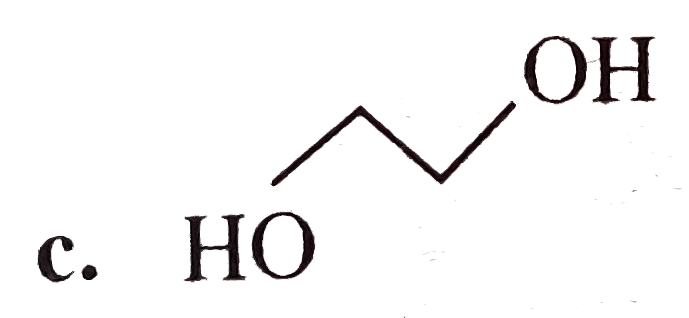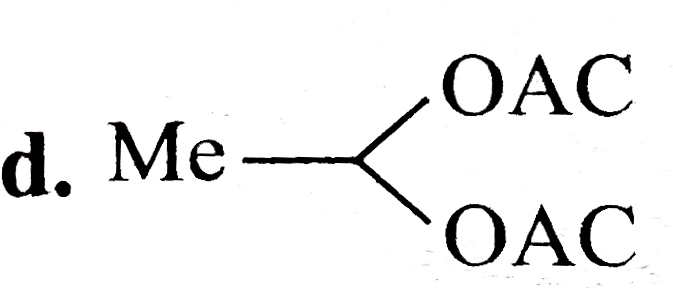H−≡−H(i)O3−−−−−−−−−−−→(ii)(H2O)/(Zn)(A)Zn/CH3COOH−−−−−−−−−→(B)
Compound (B):

(b) Me−COOH

d. 
The correct Answer is:C
To solve the problem, we will go through the reactions step by step, starting from the alkyne and determining the final compound (B) formed after the reactions with ozone (O3), zinc (Zn), and acetic acid (CH3COOH).
Step 1: Identify the starting compound
The starting compound is an alkyne, which is represented as H-C≡C-H (ethyne or acetylene).
Step 2: Ozonolysis of the alkyne
When the alkyne reacts with ozone (O3), it undergoes ozonolysis. This reaction cleaves the triple bond and forms carbonyl compounds. The reaction can be represented as follows:
H-C≡C-H+O3→H-C(=O)-C(=O)-H
This results in the formation of a compound known as an aldehyde, specifically glyoxal (H2C=O-C(=O)H).
Step 3: Reduction of the ozonolysis product
Next, the product from the ozonolysis (glyoxal) is treated with zinc (Zn) and water (H2O). The zinc reduces the carbonyl groups (C=O) to hydroxyl groups (C-OH). The reaction can be represented as:
H-C(=O)-C(=O)-H+Zn+H2O→H-C(OH)-C(OH)-H
This results in the formation of a compound with two hydroxyl groups, specifically glycerol (C3H8O3).
Step 4: Final product formation with acetic acid
Finally, when glycerol is treated with acetic acid (CH3COOH) in the presence of zinc, no significant change occurs to the structure of glycerol. Therefore, the final compound (B) remains as glycerol.
Conclusion
The final compound (B) formed after the reactions is glycerol (C3H8O3).
Summary of the steps:
1. Start with the alkyne (H-C≡C-H).
2. React with O3 to form glyoxal (H-C(=O)-C(=O)-H).
3. Reduce glyoxal with Zn and H2O to form glycerol (H-C(OH)-C(OH)-H).
4. Treat glycerol with acetic acid, resulting in no change.
Final Answer:
Compound (B) is Glycerol (C3H8O3).
The starting compound is an alkyne, which is represented as H-C≡C-H (ethyne or acetylene).
When the alkyne reacts with ozone (O3), it undergoes ozonolysis. This reaction cleaves the triple bond and forms carbonyl compounds. The reaction can be represented as follows:
H-C≡C-H+O3→H-C(=O)-C(=O)-H
This results in the formation of a compound known as an aldehyde, specifically glyoxal (H2C=O-C(=O)H).
Next, the product from the ozonolysis (glyoxal) is treated with zinc (Zn) and water (H2O). The zinc reduces the carbonyl groups (C=O) to hydroxyl groups (C-OH). The reaction can be represented as:
H-C(=O)-C(=O)-H+Zn+H2O→H-C(OH)-C(OH)-H
This results in the formation of a compound with two hydroxyl groups, specifically glycerol (C3H8O3).
Finally, when glycerol is treated with acetic acid (CH3COOH) in the presence of zinc, no significant change occurs to the structure of glycerol. Therefore, the final compound (B) remains as glycerol.
The final compound (B) formed after the reactions is glycerol (C3H8O3).
1. Start with the alkyne (H-C≡C-H).
2. React with O3 to form glyoxal (H-C(=O)-C(=O)-H).
3. Reduce glyoxal with Zn and H2O to form glycerol (H-C(OH)-C(OH)-H).
4. Treat glycerol with acetic acid, resulting in no change.
Compound (B) is Glycerol (C3H8O3).
Topper's Solved these Questions
- ALKYNESBOOK - CENGAGE CHEMISTRY ENGLISHCHAPTER - ALKYNESEXERCISE - Exercises (Archives - Single Correct Answer Type)
6 Videos
- ALKYNESBOOK - CENGAGE CHEMISTRY ENGLISHCHAPTER - ALKYNESEXERCISE - Exercises (Archives - Fill in the Blanks Type)
3 Videos
- ALKYNESBOOK - CENGAGE CHEMISTRY ENGLISHCHAPTER - ALKYNESEXERCISE - Exercises (Multiple Correct Answers Type)
25 Videos
- ALKENES AND ALKADIENESBOOK - CENGAGE CHEMISTRY ENGLISHCHAPTER - ALKENES AND ALKADIENESEXERCISE - Single correct Answer
14 Videos
- APPENDIX - INORGANIC VOLUME 1BOOK - CENGAGE CHEMISTRY ENGLISHCHAPTER - APPENDIX - INORGANIC VOLUME 1EXERCISE - chapter-7 Single correct answer
1 Video
Similar Questions
Knowledge Check
H2C=CH−CH2−C∣OHH−CH3SOCl2−−−−→Pyridine(A)O3/Zn−−−−→(H2O)(B)C5H9ClONaBH4−−−−→(C)
Compound (C) is :ACH3−OH∣CH−CH2−C∣ClH−CH3BHOCH2−CH2−CH2−CH2−CH2−CH2−ClCHO−CH2−CH2−CH2−Cl∣CH−CH3DHO−CH2−CH2−C∣ClH−CH2−CH3
Phenol (i) NaOH−−−−→(ii) CO2(A)H+/H2O−−−−−→(B)Ac2O−−→(C)
In this reaction , identify the incorrect statement?
View SolutionGive the formulae of [A] and [B]
CH3CH2MgBr+CO2(i)Dry ether−−−−−−−−→(ii)H+/H2O[A]PCl5−−→[B]
View SolutionComplete the following reaction sequence :
CH3−O∣∣C−CH3(i)CH3MgBr−−−−−−−−→(ii)H2O(A)Na metal−−−−→ether(B)CH3−Br−−−−−→(C)
View SolutionComplete the following reaction sequence :
CH3−O∣∣C−CH3(i)CH3MgBr−−−−−−−−→(ii)H2O(A)Na metal−−−−→ether(B)CH3−Br−−−−−→(C)
View SolutionConsider the following reaction (A)(i)O3−−−−−−−→(ii)H2O/ZnCH3−O∣∣C−CH2−O∣∣C−CH2−O∣∣C−CH3+3HCHO Compound 'A' will be
View SolutionConsider the following sequence of reactions
C2H5C≡CHCH3MgBr−−−−−→A(1)HCHO−−−−−−→(2)H2O+B
The product (B) is
View SolutionThe missing structures A and B in the recation sequence:
R−CH2−CH2OHAI(2)O3−−−−−→350∘CR−CH=CH2(i)O3−−−−−−−→(ii)Zn/H3O
RCHO+A,RCHOReduct−−−→B, are
View Solution
